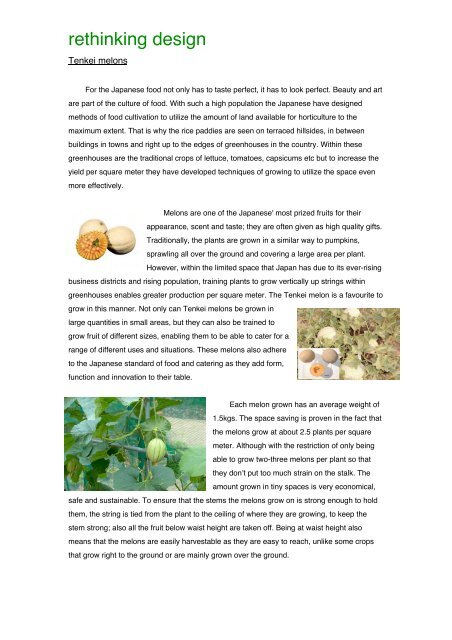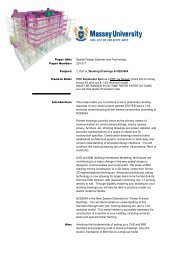rethinking design - Spatial Design@Massey
rethinking design - Spatial Design@Massey
rethinking design - Spatial Design@Massey
You also want an ePaper? Increase the reach of your titles
YUMPU automatically turns print PDFs into web optimized ePapers that Google loves.
ethinking <strong>design</strong>Tenkei melonsFor the Japanese food not only has to taste perfect, it has to look perfect. Beauty and artare part of the culture of food. With such a high population the Japanese have <strong>design</strong>edmethods of food cultivation to utilize the amount of land available for horticulture to themaximum extent. That is why the rice paddies are seen on terraced hillsides, in betweenbuildings in towns and right up to the edges of greenhouses in the country. Within thesegreenhouses are the traditional crops of lettuce, tomatoes, capsicums etc but to increase theyield per square meter they have developed techniques of growing to utilize the space evenmore effectively.Melons are one of the Japanese' most prized fruits for theirappearance, scent and taste; they are often given as high quality gifts.Traditionally, the plants are grown in a similar way to pumpkins,sprawling all over the ground and covering a large area per plant.However, within the limited space that Japan has due to its ever-risingbusiness districts and rising population, training plants to grow vertically up strings withingreenhouses enables greater production per square meter. The Tenkei melon is a favourite togrow in this manner. Not only can Tenkei melons be grown inlarge quantities in small areas, but they can also be trained togrow fruit of different sizes, enabling them to be able to cater for arange of different uses and situations. These melons also adhereto the Japanese standard of food and catering as they add form,function and innovation to their table.Each melon grown has an average weight of1.5kgs. The space saving is proven in the fact thatthe melons grow at about 2.5 plants per squaremeter. Although with the restriction of only beingable to grow two-three melons per plant so thatthey donʼt put too much strain on the stalk. Theamount grown in tiny spaces is very economical,safe and sustainable. To ensure that the stems the melons grow on is strong enough to holdthem, the string is tied from the plant to the ceiling of where they are growing, to keep thestem strong; also all the fruit below waist height are taken off. Being at waist height alsomeans that the melons are easily harvestable as they are easy to reach, unlike some cropsthat grow right to the ground or are mainly grown over the ground.













